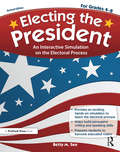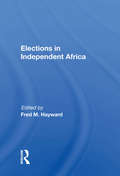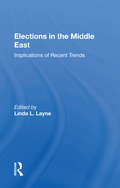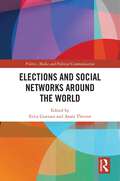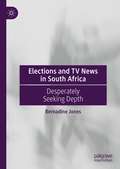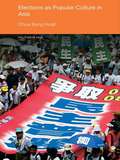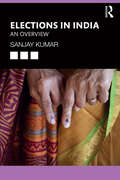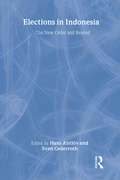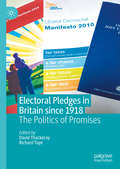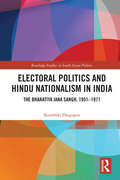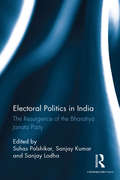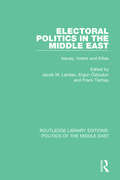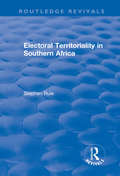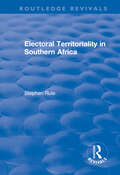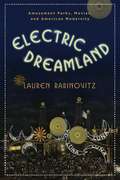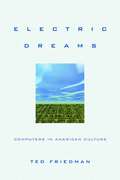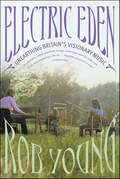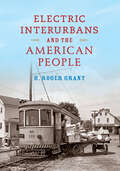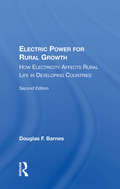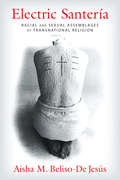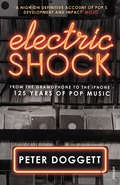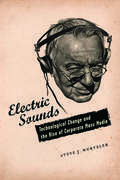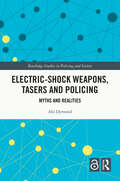- Table View
- List View
Electing the President: An Interactive Simulation on the Electoral Process (Rev. Ed., Grades 4-8)
by Betty M. SecElecting the President is a motivating, hands-on simulation that lets students experience the exciting process of electing the President and Vice President of the United States. As the two parties square off, students take on the roles of candidates, convention delegates, and members of the Electoral College. Updated to reflect the most recent Census data, this book includes complete teacher instructions and all necessary student handouts to provide an easy-to-stage simulation that can be used with small or large groups.
Elections In Independent Africa
by Fred M. HaywardThe electoral process has been an integral part of the political landscape of independent Africa for more than a quarter-century and has roots going back to traditional African societies. An examination of the independence period demonstrates the rich diversity of forms, experiences, and meanings of elections in Africa. For some observers, elections are a clear example of multiple failures in Africa-the failure of democracy and institutional transfer and the breakdown of much of the African political process in general. The authors of this book argue that elections in Africa have played a much more significant role than has commonly been recognized; that in spite of problems, elections are an important part of African contemporary political life. It has been too easy to dismiss elections in Africa as irrelevant because there are fewer today than there were two decades ago or because they have frequently failed to conform to democratic norms. However, in a period in which the primary trends of government are toward exclusion, African elections provide one of the few instruments of political action open to civil society. This study of the electoral process suggests a number of themes and conclusions about the relationship of the electoral process to state power and institutions, elite competition, mass participation, legitimacy and its limits, ethnic conflict, mobilization, party competition, authoritarian regimes, the growing incidence of electoral violence, and mass support for democratic values. Fred M. Hayward's substantive introduction discusses the electoral process in general. Eight case studies of key African countries then illustrate the varied meanings and implications of elections in independent Africa, and in the final chapter Hayward draws conclusions about the role and impact of elections. It is clear that although electoral processes have demonstrated a certain fragility, both the form and the process have shown remarkable resilience.
Elections In The Middle East: Implications Of Recent Trends
by Linda LayneThe far-reaching impact of the latest parliamentary elections in the Middle East is examined in this volume. After an introduction that analyses the trends illustrated by the elections and their implications for regional stability, the book discusses recent elections in Turkey, Egypt, Israel, Jordan, and Kuwait. Individual chapters analyze the influence of pre-1980 patterns in the party system and voting on Turkey's 1983 election; the balloting in Egypt's 1984 election as a turning point toward democratization in contemporary Egyptian politics; the significance of Israel's 1984 election in view of the relatively small differences in objectives between Israel's right-wing Likud and the centrist Labor party; the role of traditional tribal influences and new political factions in Jordan's 1984 elections; and the influence of newly emerging social groups in Kuwait's 1985 election. The contributors discuss differences in party programs and platforms, the extent of control by elites, and the relevance of the elections to crucial economic and social problems and political stability
Elections and Social Networks around the World (Politics, Media and Political Communication)
by Erica Guevara Theviot, AnaïsThis book analyzes the role of social networks during electoral campaigns around the world, taking into account the non‑technological particularities (political, electoral, social, economic, cultural) of the media configurations of different countries.Political parties all over the world engage in real virtual battles to appear at the cutting edge of technology. Providing in‑depth case studies from across Europe, North America, Latin America, Asia, and Africa, this book emphasizes the need to study how institutions, culture, and politics shape the processes of technology diffusion in each context. It asks: what are the uses of social networks in election campaigns in different countries? and what are the factors that lead to social networks playing an important role in the elections of a given country? International and comparative in focus, this book brings together work on the uses of social networks (Facebook, X (formerly Twitter), WhatsApp, TikTok, Instagram, Telegram, and more) in the context of an election campaign by different actors (such as parties, companies, journalists, and voters). This book explores the different methodological and theoretical approaches developed for the study of the uses of social networks in an electoral context. The contributors focus on the identification of the “online ecosystem” of electoral actors in each country, studying their strategies and logic. They also analyze the scaremongering rhetoric about the possible effect of social media on elections as an object of study. While taking seriously the issues of polarization, disinformation, or negative campaigning, this book provides understanding of how these work and how their discourses are constructed.This book will be of great interest to upper‑level students and scholars of Political Science, Media, and Communications Studies.
Elections and TV News in South Africa: Desperately Seeking Depth
by Bernadine JonesThis book takes television news seriously. Over the course of nine chapters, Elections and TV News in South Africa shows how six democratic South African general elections, 1994–2019, were represented on both local and international news broadcasts. It reveals the shifting narratives about South African democracy, coupled with changing and challenging political journalism practices. The book is organised in three parts: the first contains a history of South African democracy and an overview of the South African media environment. The second part is a visual analysis of the South African elections on television news, exploring portrayals of violence, security, power, and populism, and how these fit into normative news values and the ruling party’s tightening grip on the media. The final part is a conclusion, a call to action, and a suggestion to improve political journalistic practice.
Elections as Popular Culture in Asia (Politics in Asia)
by Chua Beng HuatConventional political science depicts legitimate elections as rational affairs in which informed voters select candidates for office according to how their coherently presented aims, ideologies and policies appeal to the self-interest of the electorate. In reality elections, whether in first world democracies, or in the various governmental systems present in Asia, can more realistically be seen as cultural events in which candidates’ campaigns are shaped, consciously or unconsciously, to appeal to the cultural understanding and practices of the electorate. The election campaign period is one in which the masses are mobilized to participate in a range of cultural activities, from flying the party colours in noisy motorcycle parades to attending political rallies for or against, or simply to be entertained by the performances on the political stage, and to gambling on the outcome of the contest. The essays in this book analyse electioneering activities in nine Asian countries in terms of popular cultural practices in each location, ranging from updated traditional cultures to mimicry and caricatures of present day television dramas. In presenting political election as an expression of popular culture this book portrays electoral behaviour as a meaningful cultural practice. As such this book will appeal to student and scholars of political science and cultural studies alike, as well as those with a more general interest in Asian studies.
Elections in India: An Overview
by Sanjay KumarThis book looks at the patterns and trends of participation in Indian elections since 1952 – the first elections held in independent India. It engages with debates around the nature of the multi-party electoral politics in India and its impact on the voting behaviour of Indian voters. The book uses extensive empirical data from the state and national elections to analyze the history and evolution of the country’s electoral systems as well as the challenges and safeguards for conducting fair elections in the world’s largest democracy. The author explores the trends in turnout in regional and national elections and its relationship with electoral outcomes. He analyzes electoral patterns over the last seven decades as well as patterns of participation of marginalized groups, the younger population, and the narrowing gap of women’s electoral participation. The book discusses the role of money, the criminalization of electoral politics, and its influence on Indian elections. It also focuses on the issue of irregular delimitation of electoral constituencies and its implication on political representation. Topical and comprehensive, this book will be an essential read for scholars and researchers of political studies, political sociology, public administration and governance, and South Asian studies. It will also be useful for journalists and think tanks interested in India’s electoral processes and debates. It could serve as a guidebook as well for those interested in the nitty-gritty of Indian elections.
Elections in Indonesia: The New Order and Beyond
by Hans Antlöv and Sven CederrothIt has sometimes been argued that many Indonesians had little sympathy with western notions of elections being events for the contesting and transfer of power and that they rather supported the New Order's use of 'festivals of democracy', elections as occasions at which the mass of ordinary Indonesians were given the opportunity to celebrate the country's achievements under the rule of its New Order leadership as well as legitimize the continued rule of these leaders. But the need to stage-manage these 'elections' as New Order triumphs finally undid the regime. With chapters describing the last New Order election and the first free election in the post-Suharto era, this volume makes an important contribution to our understanding of the demise of the New Order, and the directions being taken by the emerging regime.
Electoral Pledges in Britain Since 1918: The Politics of Promises
by Richard Toye David ThackerayNobody doubts that politicians ought to fulfil their promises – what people cannot agree about is what this means in practice. The purpose of this book is to explore this issue through a series of case studies. It shows how the British model of politics has changed since the early twentieth century when electioneering was based on the articulation of principles which, it was expected, might well be adapted once the party or politician that promoted them took office. Thereafter manifestos became increasingly central to electoral politics and to the practice of governing, and this has been especially the case since 1945. Parties were now expected to outline in detail what they would do in office and explain how the policies would be paid for. Brexit has complicated this process, with the ‘will of the people’ as supposedly expressed in the 2016 referendum result clashing with the conventional role of the election manifesto as offering a mandate for action.
Electoral Politics and Hindu Nationalism in India: The Bharatiya Jana Sangh, 1951–1971 (Routledge Studies in South Asian Politics)
by Koushiki DasguptaThis book analyses the rise and growth of the Hindu nationalist party Bharatiya Jana Sangh in post independent India, tracking the electoral journey of the party from 1951 to 1971. Offering a comprehensive analysis of the party Bharatiya Jana Sangh - its origin, ideas and electoral performances in the first two decades of its journey - the book provides an overview of the state-wise electoral record of the party mobilizing Hindu support and managing factional disputes. It surveys the issues of conflicts between the intraparty factions dominated by the recruits from the Rastriya Swayamseyak Sangh and the others. The author also presents a critique of the Hindutva politics of the Bharatiya Jana Sangh on account of its somewhat imperfect appeal among the masses and its problems in raising real issues of socio-economic concern. With a special emphasis on the states situated outside the Hindi language belt of Northern India, the electoral outcome of the Jana Sangh during each national and state legislative elections are analysed. Based on the dialectics of ideology and exigency, this book makes a thorough investigation of the leadership-succession crises in the party, patterns of vote sharing at the regional level and trends of coalition with the non-Congress parties in the states. Providing a nuanced understanding of the processes leading to the strengthening of right-wing political parties in India, the book will be of interest to academics working in the fields of nationalism, party politics and South Asian Politics.
Electoral Politics in India: The Resurgence of the Bharatiya Janata Party
by Sanjay Kumar Suhas Palshikar Sanjay LodhaThe general elections held in 2014 in India — the largest democracy in the world — to elect the 16th Lok Sabha brought in dramatic results. This important volume explains not only the startling victory of the Bharatiya Janata Party (BJP) but also the equally surprising downfall of the Congress Party. It examines not why BJP won and the Congress lost, but why the scale of BJP’s victory and that of Congress’s defeat was so very different from the results in the years 2004 and 2009. The volume presents an in-depth analysis of the electoral results, state-wise studies, the factors leading up to these outcomes, and the road India has travelled since then. With contributions from India’s leading political scientists, psephologists, sociologists and political commentators, this book will be of great interest to scholars and researchers of Indian politics, democracy and political parties, as well as South Asian studies.
Electoral Politics in the Middle East: Issues, Voters and Elites (Routledge Library Editions: Politics of the Middle East #10)
by Jacob M. Landau Frank Tachau ErgunComparative political study of the Middle East got off to a late start. Unlike any previous studies in comparative politics, this book, first published in 1980, represents an important methodological advance in that it proceeds by themes rather than by countries, and uniquely focuses on three major aspects of electoral politics in three contemporary Middle Eastern states. The three countries – Turkey, Lebanon and Israel – are chosen because they are the only Middle Eastern countries with a tradition of free elections. On the other hand, they also display certain characteristics found in other, non-competitive Middle Eastern political systems, such as the role and prominence of religion. The study is based on extensive original research and presents the first comparative treatment of electoral issues, voting behaviour and parliamentary elites, emphasising the context of rapid socio-economic change – a theme particularly pertinent to those countries with their tradition of free elections. The variety of political behaviour within the countries concerned, coupled with the prevailing complexities resulting from disparities in language and cultural inheritance, makes the comparative approach particularly revealing. The attitudes and behaviour of the voters can be seen to be at least as important as the laws and mechanisms involved.
Electoral Territoriality in Southern Africa (Routledge Revivals)
by Stephen RuleThis title was first published in 2000. A comprehensive comparison of voting patterns in seven countries of Southern Africa. The modern democratic electoral histories of Botswana, Lesotho, Namibia, South Africa, Swaziland, Zambia and Zimbabwe are placed within the contexts of their pre-colonial and colonial polities. The extent to which urbanization and the regional distribution of language, ethnicity and race impacts on the electoral geography of the sub-continent is demonstrated statistically and cartographically. The analysis is complemented by anecdotal evidence gathered during personal interviews and discussions with voters, politicians, government officials and academics.
Electoral Territoriality in Southern Africa (Routledge Revivals)
by Stephen RuleThis title was first published in 2000. A comprehensive comparison of voting patterns in seven countries of Southern Africa. The modern democratic electoral histories of Botswana, Lesotho, Namibia, South Africa, Swaziland, Zambia and Zimbabwe are placed within the contexts of their pre-colonial and colonial polities. The extent to which urbanization and the regional distribution of language, ethnicity and race impacts on the electoral geography of the sub-continent is demonstrated statistically and cartographically. The analysis is complemented by anecdotal evidence gathered during personal interviews and discussions with voters, politicians, government officials and academics.
Electric Dreamland: Amusement Parks, Movies, and American Modernity
by Lauren RabinovitzLauren Rabinovitz describes the urban modernity engendered by these parks and their media, encouraging ordinary individuals to sense, interpret, and embody a burgeoning national identity.
Electric Dreamland: Amusement Parks, Movies, and American Modernity (Film and Culture Series)
by Lauren RabinovitzAmusement parks were the playgrounds of the working class in the early twentieth century, combining numerous, mechanically-based spectacles into one unique, modern cultural phenomenon. Lauren Rabinovitz describes the urban modernity engendered by these parks and their media, encouraging ordinary individuals to sense, interpret, and embody a burgeoning national identity. As industrialization, urbanization, and immigration upended society, amusement parks tempered the shocks of racial, ethnic, and cultural conflict while shrinking the distinctions between gender and class. Following the rise of American parks from 1896 to 1918, Rabinovitz seizes on a simultaneous increase in cinema and spectacle audiences and connects both to the success of leisure activities in stabilizing society. Critics of the time often condemned parks and movies for inciting moral decline, yet in fact they fostered women's independence, racial uplift, and assimilation. The rhythmic, mechanical movements of spectacle also conditioned audiences to process multiple stimuli. Featuring illustrations from private collections and accounts from unaccessed archives, Electric Dreamland joins film and historical analyses in a rare portrait of mass entertainment and the modern eye.
Electric Dreams: Computers in American Culture
by Ted FriedmanElectric Dreams turns to the past to trace the cultural history of computers. Ted Friedman charts the struggles to define the meanings of these powerful machines over more than a century, from the failure of Charles Babbage’s “difference engine” in the nineteenth century to contemporary struggles over file swapping, open source software, and the future of online journalism. To reveal the hopes and fears inspired by computers, Electric Dreams examines a wide range of texts, including films, advertisements, novels, magazines, computer games, blogs, and even operating systems.Electric Dreams argues that the debates over computers are critically important because they are how Americans talk about the future. In a society that in so many ways has given up on imagining anything better than multinational capitalism, cyberculture offers room to dream of different kinds of tomorrow.
Electric Eden: Unearthing Britain's Visionary Music
by Rob YoungA Kirkus Reviews Best Nonfiction of 2011 title In the late 1960s, with popular culture hurtling forward on the sounds of rock music, some brave musicians looked back instead, trying to recover the lost treasures of English roots music and update them for the new age. The records of Fairport Convention, Pentangle, Steeleye Span, and Nick Drake are known as "folk rock" today, but Rob Young's epic, electrifying book makes clear that those musicians led a decades-long quest to recover English music-and with it, the ancient ardor for mysticism and paganism, for craftsmanship and communal living.It is a commonplace that rock and R&B came out of the folk and blues revivals of the early 1960s, and Young shows, through enchanting storytelling and brilliant commentary, that a similar revival in England inspired the Beatles and Pink Floyd, Led Zeppelin and Traffic, Kate Bush and Talk Talk. Folklorists notated old songs and dances. Marxists put folk music forward as the true voice of the people. Composers like Benjamin Britten and Ralph Vaughan Williams devised rich neo-traditional pageantry. Today, the pioneers of the "acid folk" movement see this music as a model for their own.Electric Eden is that rare book which has something truly new to say about popular music, and like Greil Marcus's LipstickTraces, it uses music to connect the dots in a thrilling story of art and society, of tradition and wild, idiosyncratic creativity.
Electric Interurbans and the American People (Railroads Past and Present)
by H. Roger Grant“A well-written social history of the shortest-lived major US transportation mode” from the railway historian and author of A Mighty Fine Road (Choice).One of the most intriguing yet neglected pieces of American transportation history, electric interurban railroads were designed to assist shoppers, salesmen, farmers, commuters, and pleasure-seekers alike with short distance travel. At a time when most roads were unpaved and horse and buggy travel were costly and difficult, these streetcar-like electric cars were essential to economic growth. But why did interurban fever strike so suddenly and extensively in the Midwest and other areas? Why did thousands of people withdraw their savings to get onto what they believed to be a “gravy train?” How did officials of competing steam railroads respond to these challenges to their operations? H. Roger Grant explores the rise and fall of this fleeting form of transportation that started in the early 1900s and was defunct just 30 years later. Perfect for railfans, Electric Interurbans and the American People is a comprehensive contribution for those who love the flanged wheel.“With this book, the subject no longer has footnote status. In fact, Grant’s work deserves a place alongside some of the other landmark surveys of the subject . . . Here, Grant moves beyond the receiverships, the rickety track, and all that fascinating rolling stock. He shows us why the whole darned thing mattered.” —Railroad History“H. Roger Grant has produced a fine social history of America’s electric interurbans, exploring the relationship between people and those railway enterprises. The book fills a void, is eminently readable, and richly illustrated.” —Don L. Hofsommer, author of Off the Main Lines
Electric Power For Rural Growth: How Electricity Affects Rural Life In Developing Countries
by Douglas F. BarnesThis book offers important historical information on the state of rural electrification in the 1980s. It also summarizes the development of benefit evaluation methods, along with findings from recent research on the impact of rural electrification for development.
Electric Santería: Racial and Sexual Assemblages of Transnational Religion (Gender, Theory, and Religion)
by Aisha Beliso-De JesúsSantería is an African-inspired, Cuban diaspora religion long stigmatized as witchcraft and often dismissed as superstition, yet its spirit- and possession-based practices are rapidly winning adherents across the world. Aisha M. Beliso-De Jesús introduces the term "copresence" to capture the current transnational experience of Santería, in which racialized and gendered spirits, deities, priests, and religious travelers remake local, national, and political boundaries and reconfigure notions of technology and transnationalism.Drawing on eight years of ethnographic research in Havana and Matanzas, Cuba, and in New York City, Miami, Los Angeles, and the San Francisco Bay area, Beliso-De Jesús traces the phenomenon of copresence in the lives of Santería practitioners, mapping its emergence in transnational places and historical moments and its ritual negotiation of race, imperialism, gender, sexuality, and religious travel. Santería's spirits, deities, and practitioners allow digital technologies to be used in new ways, inciting unique encounters through video and other media. Doing away with traditional perceptions of Santería as a static, localized practice or as part of a mythologized "past," this book emphasizes the religion's dynamic circulations and calls for nontranscendental understandings of religious transnationalisms.
Electric Shock: From the Gramophone to the iPhone – 125 Years of Pop Music
by Peter DoggettAmbitious and groundbreaking, Electric Shock tells the story of popular music, from the birth of recording in the 1890s to the digital age, from the first pop superstars of the twentieth century to the omnipresence of music in our lives, in hit singles, ringtones and on Spotify. Over that time, popular music has transformed the world in which we live. Its rhythms have influenced how we walk down the street, how we face ourselves in the mirror, and how we handle the outside world in our daily conversations and encounters. It has influenced our morals and social mores; it has transformed our attitudes towards race and gender, religion and politics. From the beginning of recording, when a musical performance could be preserved for the first time, to the digital age, when all of recorded music is only a mouse-click away; from the straitlaced ballads of the Victorian era and the ‘coon songs’ that shocked America in the early twentieth century to gangsta rap, death metal and the multiple strands of modern dance music: Peter Doggett takes us on a rollercoaster ride through the history of music. Within a narrative full of anecdotes and characters, Electric Shock mixes musical critique with wider social and cultural history and shows how revolutionary changes in technology have turned popular music into the lifeblood of the modern world.
Electric Sounds: Technological Change and the Rise of Corporate Mass Media
by Stephen WurtzlerA history of sound recording and reproduction and how this technology transformed American mass media.
Electric Sounds: Technological Change and the Rise of Corporate Mass Media (Film and Culture Series)
by Steve WurtzlerElectric Sounds brings to vivid life an era when innovations in the production, recording, and transmission of sound revolutionized a number of different media, especially the radio, the phonograph, and the cinema. The 1920s and 1930s marked some of the most important developments in the history of the American mass media: the film industry's conversion to synchronous sound, the rise of radio networks and advertising-supported broadcasting, the establishment of a federal regulatory framework on which U.S. communications policy continues to be based, the development of several powerful media conglomerates, and the birth of a new acoustic commodity in which a single story, song, or other product was made available to consumers in multiple media forms and formats.But what role would this new media play in society? Celebrants saw an opportunity for educational and cultural uplift; critics feared the degradation of the standards of public taste. Some believed acoustic media would fulfill the promise of participatory democracy by better informing the public, while others saw an opportunity for manipulation. The innovations of this period prompted not only a restructuring and consolidation of corporate mass media interests and a shift in the conventions and patterns of media consumption but also a renegotiation of the social functions assigned to mass media forms. Steve J. Wurtzler's impeccably researched history adds a new dimension to the study of sound media, proving that the ultimate form technology takes is never predetermined. Rather, it is shaped by conflicting visions of technological possibility in economic, cultural, and political realms. Electric Sounds also illustrates the process through which technologies become media and the ways in which media are integrated into American life.
Electric-Shock Weapons, Tasers and Policing: Myths and Realities (Routledge Studies in Policing and Society)
by Abi DymondBuilding on five years of research, and drawing on criminology, science and technology studies (STS), socio-legal studies and social psychology, this book is the first non-medical book written on electric-shock weapons, of which the best well known is the TASER brand. The police’s ability to use force is one of their most crucial powers, yet one that has been relatively neglected by criminology. This book challenges some of the myths surrounding the use of these weapons and considers their human rights implications and impact on members of the public and officers alike. Drawing on STS, it also considers the role and impact of electric-shock technologies, examines the extent to which technologies and non-human agency may also play a role in shaping officer decision making and discretion, and contributes to long standing debates about police accountability. This is essential reading for policing scholars around the world, particularly those engaged with use of force, culture and accountability, as well as those engaged with Science and Technology studies.
